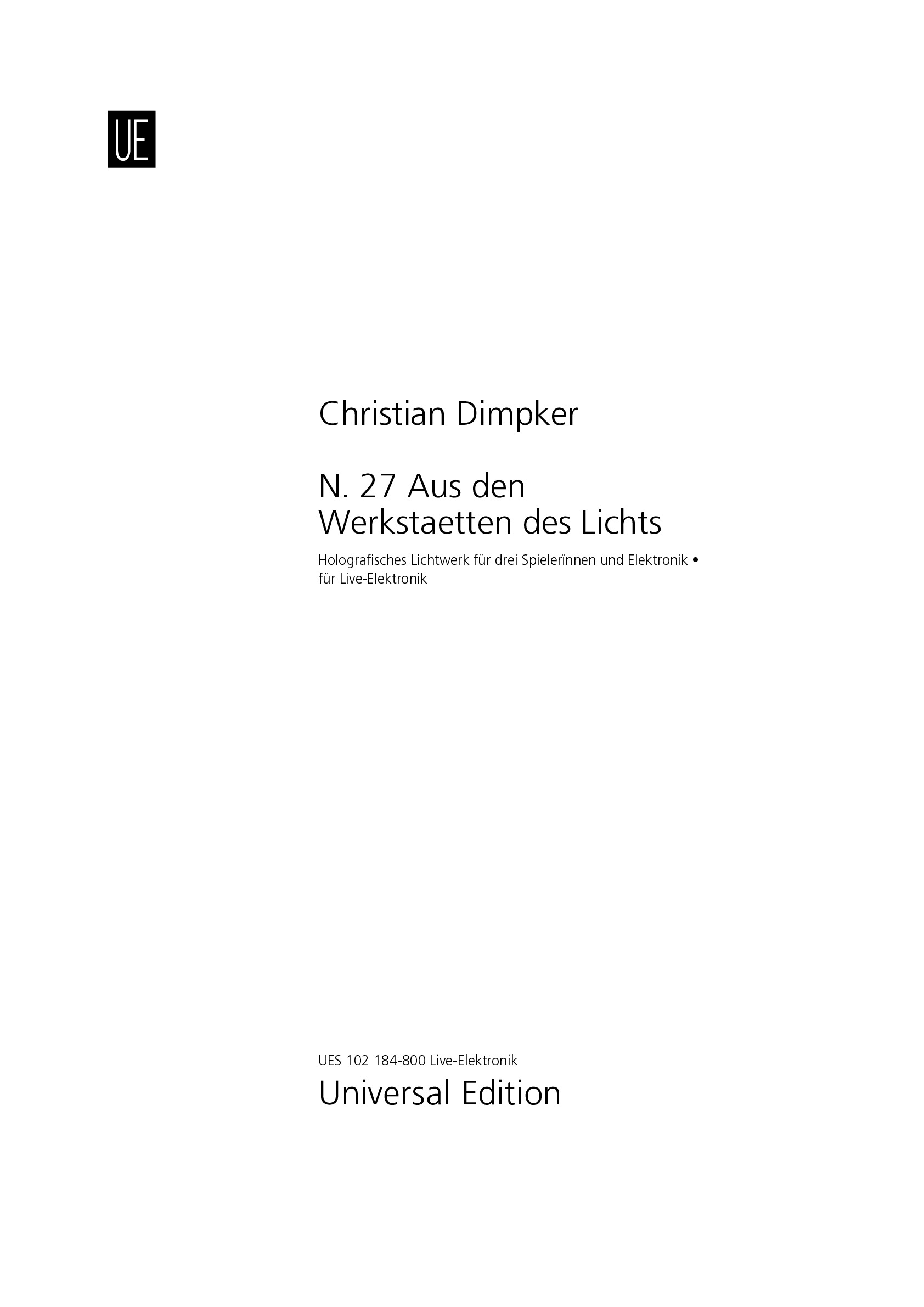

Christian Dimpker
N. 27 Aus den Werkstätten des Lichts
Duration: 10'
Solos:
live electronics
N. 27 Aus den Werkstätten des Lichts
Translation, reprints and more

Christian Dimpker
N. 27 Aus den Werkstätten des LichtsType: Noten
Sample pages
Work introduction
Aus den Werkstätten des Lichts marks the beginning of a new work phase – which overcomes instrumental sound producers by turning towards light. All details of the work – light and sound – can be accessed by means of the associated score. The work can thus be realised again and again using these notations. The Werkstätten des Lichts completely abandon traditional notation as only unconventional elements are used. At the same time, they feed on the conventions or, respectively, have emerged from them in order to extend notation to the visual arts. The piece was preceded by an extensive research work without which it would not have been possible to compose it. The first piece of this kind examines the waveform character of light (and sound) through the visualisation (and sonification) of diffraction as well as interference. Telescopes are used to visualise these phenomena, while flexible acoustic and visual barriers surround the speakers and spotlights. The visual part also incorporates the method of holographic interferometry. This interference between two images is explored by means of acoustic resonance. Additionally, contact microphones pick up the resulting vibrations.
What is necessary to perform this work?
The setup can be found on pp. V f. The piece is intended for three players (any trained instrumentalist/singer) and a sound director. The lasers, holograms and sounds are automatically played (controlled by the sound director) while the players work with a synchronized metronome in the ear (possibly via wireless headphones). No (additional ADSR) envelopes are notated for the synthetic sounds. The interpreters should keep this in mind and add them at their own discretion. The room is completely submerged in darkness, only the scores are lit by small lights. Fog, smoke or haze machines can be used to support the visibility of the lasers. The three players wear laser safety glasses. Player 1 works with laser A and speakers 1/2, player 2 with laser B and speakers 3/4 and player 3 with beam C and spotlights 5/6. The sound director does the preliminary work and employs the filters / transformers of the spotlights and the filters of projector C during the performance. The room is divided into four vertical levels. In the lowest level, the four speakers, the sub-woofer and the two spotlights are situated. The next level is above the heads of the audience. On this level, projectors A-C and α/β are installed. They are placed on stands, while projector C is accessible for the sound director via a ladder. At the next higher level, the lasers A/B as well as the mirrors, lenses and telescopes connected to them are hanging on a truss structure. On this truss structure, laser C, the lens connected to it and its telescopes are installed. The players may stand on scaffolds. The images of projector A are supposed to overlap with the images of projector α and the light of spotlight 5 on screen A’, the images of projector B with the images of projector β and the light of spotlight 6 on screen B’ as well as the images of projector C with beam C on screen C’.
Construction: Laser A sends a beam across the room via a prism and mirrors until it hits the Barlow lens and the telescope. Through the mirrors, this beam is reflected through the room until it arrives at the telescope. There is a gap between the two telescopes. At this gap, the player can interact with the beam, inserting various objects to bend the beams (diffraction) or refract them (by passing them through other media). The light thus changed is then picked up by the second telescope, filmed by the video camera and sent to projector A to the opposite screen A’. Additionally, light material produced in the same manner is pre-recorded (see score) and transmitted to the same screen by means of a player and projector β. Laser B emits three beams. They are bundled by the convergent lens and brought by a further converging lens at or shortly after the focal point back to a parallel path. Likewise, the player can then interact with the light in the gap between the telescopes. Again, the light is filmed and sent by projector B to screen B’. Another recording is also sent to the same screen via projector β. At the next higher level, laser C is amplified by means of a convergent lens and passes through the mirrors to the telescope in order to also enable interaction. However, this light is not filmed, but reflected by means of another mirror to screen C’. In order to fine tune the set-up, additional lenses can be used. Additionally, the mirror tracks can be extended depending on the size of the room. A kind of laser firmament over the audience is supposed to be created. The spotlights are not supposed to interfere with the laser light. If the interferences between the projector light and the laser beams become too strong, the projectors may also be placed on the other side of the room and transmit to the screen from a close distance (while the image is distorted).
The speakers and spotlights are surrounded by visual / acoustic barriers. Their elements are described on p. VI. The interpreters build them at their own discretion. It is only determined that barriers consist of three stepper motors each, which can be controlled individually. Each player takes control of 6 motors. They each have a slider that allows the speed to be varied in a gliding manner. The sliders are accessible to the left of the players. U-shaped channels are placed on the motors. In these, the rectangular filters / grids / lenses are introduced and layered on top of each other. For the acoustic barriers only metal, acrylic glass and glass plates are used. The other materials listed on p. V are used for the visual barriers. They are constructed like the acoustic barriers, but should accommodate more elements. At least two of the six motors of the spotlights should also be equipped with prisms and beam splitters. The barriers should be as impermeable as possible. If necessary, add additional rigid acoustic / visual barriers above and below the equipment. In addition, six filters / transformers have to be designed for the spotlights. One page VI a possible example of such an element can be found. The filters / transformers act similar to colour filters, but are composed of various parts. They are placed directly on the spotlight and, by doing so, transform the light before it hits the barrier. The speakers reproduce the notated (abstract) electroacoustic music. Various recordings of resonating objects (see list p. V) have to be produced. The objects are picked up via contact microphones (see score for further details). If items are not available, they can also be simulated / rebuilt.
The resonating objects are also used to make holographic interferograms. The set up of this arrangement can be seen on p. VI. The principle of real-time holographic interferometry (RHI) is described by Kreis (Kreis, Thomas: Handbook of holographic interferometry, Weinheim 2005, pp. 185-189 and 269-286). This method (real-time holography and recording via CCD-arrays) can be used if it is not possible to realise the real-time colour holographic interferometry (RCHI) technique, also shown on p. VI. It can then be placed higher. The choice of the laser colour is at the players’ discretion. The RCHI method is described by Desse in a paper published in 2011 (Desse, Jean-Michel: Real-time colour holographic interferometry (from holographic plate to digital hologram). In: Naydenova, Izabela (ed.): Advanced holography. Metrology and imaging, Rijeka 2011, pp. 3-28). RCHI utilises lasers with three wavelengths (red, green, blue) to simultaneously construct the interference between the three object beams and the three reference beams on a hologram. The object is recorded both in an unexcited and in an excited state (by resonance). In terms of the choice of the laser, Desse writes: “Firstly, a laser has to be found that will supply the three primary wavelengths forming as extensive as possible a base triangle. It is an Innova Spectrum 70 ionized gas laser (mixed argon and krypton) that produces approximately 10 visible lines with a total power of 4.7 W. The three wavelengths retained are 647 nm for the red line of krypton and 514 nm and 476 nm for the green and blue lines of argon“. The other required items are described on p. VI. It might be beneficial to collaborate with a technical university to create the holograms by means of the technique described in the paper. The actual objects should not be clearly recognisable. The holograms are then played back by means of a holographic display / projector. If these are not yet available, play back a 2-D-projection (standard method applied to the score).
The piece can also be installed or simply continue after the performance. In this case, the audience takes on the role of the players. Only one person at a time may play the gap between the telescopes. This person must wear safety glasses. Before entering the installation, the spectators are given the explanation shown on p. VII and the willing ones need to wear safety glasses. The glasses must be returned on exit and cleaned quickly. The scores are presented near the telescopes. Of course, they are not meant to be followed by the spectators, but merely give them an insight into the piece. The motors may be operated by them, while the filters of the holographic projector can also be used. They are handed over to a spectator. When she comes out, she hands them over, they are cleaned and given to the next person.
